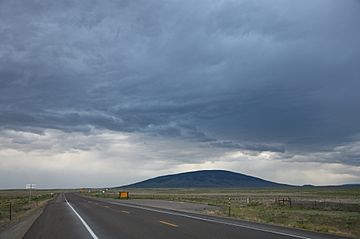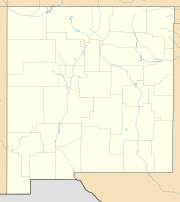San Antonio Mountain (New Mexico) facts for kids
Quick facts for kids San Antonio Mountain |
|
|---|---|

San Antonio Mountain, New Mexico, as seen from the Colorado side of the NM-CO state line on U.S. Route 285
|
|
| Highest point | |
| Elevation | 10,912 ft (3,326 m) NAVD 88 |
| Prominence | 2,108 ft (643 m) |
| Geography | |
| Location | Rio Arriba County, New Mexico, U.S. |
| Topo map | USGS San Antonio Mountain N. Mex. |
| Geology | |
| Mountain type | Shield volcano |
| Volcanic arc | Taos Plateau volcanic field |
San Antonio Mountain is a large, stand-alone volcano in Rio Arriba County, New Mexico. It stands 10,908 feet (about 3,325 meters) tall. This makes it the highest point in the Taos Plateau volcanic field. This volcanic field is the biggest one in the Rio Grande Rift valley.
The mountain is just outside the northwest edge of the Rio Grande del Norte National Monument. It is part of the Carson National Forest. The U.S. Forest Service manages this area.
The Tewa-speaking people in the Rio Grande valley call it "Bear Mountain." In their beliefs about the world, it is known as the mountain of the north.
Contents
Where is San Antonio Mountain?
San Antonio Mountain is one of many volcanoes in the Taos Plateau volcanic field. This area covers about 2,700 square miles (7,000 square kilometers). It is a place with lots of old volcanic activity. Other nearby peaks include Ute Mountain (10,082 feet), Cerro de la Olla (9,475 feet), Cerro del Aire (9,023 feet), and Cerro Montoso (8,655 feet).
San Antonio Mountain is the tallest peak in this area. It also rises the most dramatically from the land around it. However, it is not as tall as the highest mountains nearby. For example, Grouse Mesa (11,403 feet) is to the west. Wheeler Peak (13,161 feet) is to the east.
Because San Antonio Mountain stands alone, it is easy to spot. You can see it from over 60 miles away. This includes parts of southern Colorado and northern New Mexico. The mountain's base is about five miles wide. It rises sharply from the flat, sagebrush plains of the lower San Luis Valley.
How Was San Antonio Mountain Formed?
San Antonio Mountain is a type of volcano called a lava dome. It formed from lava that was thick and sticky. This lava had a lot of silica in it. The volcano erupted between 3.36 and 2.9 million years ago.
Most of the mountain is made of these thick lava flows. They can be up to 30 meters (about 100 feet) thick. The bottom parts of these flows are glassy. The middle parts are solid and gray. The top parts are broken into blocks. Sometimes, these blocks turn red from being exposed to air.
The mountain has two main tops, a north and a south summit. A shallow dip separates them. Around the southern summit, there are small pieces of rock called cinder and spatter. This shows that the southern summit was the last part to erupt. The mountain also almost covers a smaller, older volcano to its northwest.
Plants and Animals of San Antonio Mountain
The mountain is home to many different plants and animals.
Plant Life
At lower elevations, you can find Gambel oak and ponderosa pine trees. As you go higher up the mountain, you will see Douglas fir, Engelmann spruce, and quaking aspens.
Animal Life
San Antonio Mountain is a very important place for elk. Large herds of elk come here for the winter. It has one of the biggest elk populations in New Mexico, with about 7,000 elk.
The mountain and its surroundings also provide a home for other animals. These include pronghorn, golden eagles, hawks, bears, mountain lions, mule deer, and white-tailed jackrabbits. In the fall, the Stuart Meadows wetlands are nearby. These wetlands are a stopover for migrating birds. You might see Sandhill cranes, mallards, American wigeon, Northern pintail, common yellowthroat, and sora.


